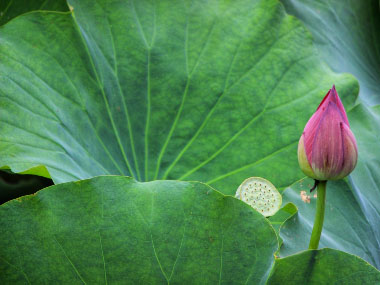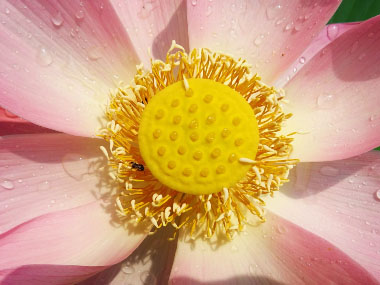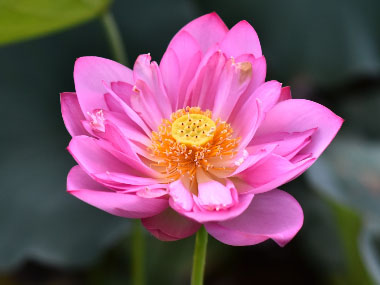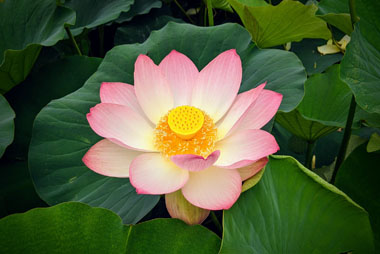






To support our efforts please browse our store (books with health benefits, etc.).
The sacred water lotus is a beautiful emergent aquatic perennial plant that has long been considered a close relative of water lilies. Sacred lotus occurs in the wild but was domesticated in Asia about 7,000 years ago for its rhizomes and seeds as a food crop. The seeds of this remarkable plant have exceptional longevity, remaining viable up to 1,300 years, and its vegetative rhizomes remain healthy for more than 50 years. The common name is sacred lotus because of its religious significance in both Buddhism and Hinduism. This perennial aquatic belongs to the plant family Nelumbonaceae. It is the national flower of India and Vietnam and in India, is known as the Indian lotus.
Distinguishing Features
The showy lotus flowers differ from those of water lilies, most notably through the obconical (ice-cream cone-shaped) receptacle in the centre, into which numerous free carpels are sunken. Once in bloom, it is very easy to identify this plant although the leaves are quite distinct as well.
Flowers
Flowers can reach to heights of 2 metres (6') above the water surface by their sturdy stalks. Each flower measures an impressive 10 to 25cm (4 to 10") across and consists of about 15 pink or white tepals, a golden receptacle and a dense ring of yellow stamens (however the anthers are often white). The plant's blooming period occurs during the summer and can last 2 months; yet individual flowers are short-lived. They open in the morning and lose their petals by the afternoon.
 Fields
of Nutrition has medicinal benefits and vitamin/mineral content of Water Lotus.
Fields
of Nutrition has medicinal benefits and vitamin/mineral content of Water Lotus.
Leaves
This perennial plant produces individual leaves directly from the root system. The blades of the leaves either float on the surface of the water, or they are held up to 5' above the water surface by their petioles. The sacred lotus plants have simple leaves that have an orbiculate (circular) shape and wavy margins. Leaf venation is palmate. Leaves are green and can reach to lengths of 45cm to 1m (18 to 36") in length.
Height
This aquatic can grow to 2 metre tall (3') but is generally half that.
Habitat
The lotus grows in tropical regions of Asia east of Iran, especially in India and Southeast Asia, China, and in Australia, and it will grow in warmer locations throughout the U.S. as well. It thrives in shallow ponds, lagoons and marshes but is often cultivated in water gardens.
Edible Parts
Its root, flower, seeds, stem and leaves are edible although the root is most commonly used. The root is a good source of starch and is cooked like a vegetable. It has a delicate taste and a nice crunchy texture, even after being sautéed. Seeds can be popped like popcorn, ground into a powder and used in making bread. Flower petals make a beautiful garnish. Leaves can be used raw or cooked.
Other Name
Sacred Water Lotus.
Similar Plants
Water Lily.
Recipes
Winter Survival Food Handbook

PDF Plant Magazines
Types of Wild Food
Geographic Zones Seasons
Disclaimer
EdibleWildFood.com is informational in nature. While we strive to be 100% accurate, it is solely up to the reader to ensure proper plant identification. Some wild plants are poisonous or can have serious adverse health effects.
We are not health professionals, medical doctors, nor are we nutritionists. It is up to the reader to verify nutritional information and health benefits with qualified professionals for all edible plants listed in this web site. Please click here for more information.
Why Edible Wild Food?
- Food costs are rising
- Free, wild food is readily abundant
- Wild food adds nutrition to your diet
- Wild food can help treat various medical conditions





